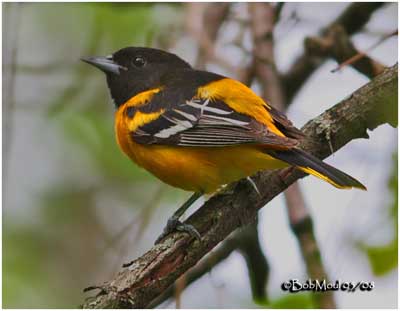
Baltimore Oriole
Icterus galbula
Passeriforme Order – Icteridae Family
BIOMETRICS:
Length: 17 à 19 cm
Wingspan: 23 à 30 cm
Weight: 30 à 40 g
LONGEVITY: Up to 14 years
DESCRIPTION:
Baltimore Oriole adult male has black hood, back, wings and tail. Underparts and rump are bright orange. Tail shows orange tip and edges. Wings are black with orange shoulders, and white wing bar. Breast is darker orange than underparts.
Bill is pointed and silver grey. Eyes are dark. Legs and feet are grey.
Fr: Oriole du Nord
All : Baltimore Trupial
Esp : Ictérido anaranjado
Ital : Oriolo di Baltimora
Nd: Noordelije troepiaal
Russe: Балтиморская иволга
Sd: Baltimoretrupial
Photographs by Bob Moul
His website :
Nature Photography
Photographs by René Lortie
His website :
http://rlortie.ca/
Text by Nicole Bouglouan
Sources :
NEW WORLD BLACKBIRDS by Alvaro Jaramillo and Peter Burke – Helm - ISBN: 0713643331
THE HANDBOOK OF BIRD IDENTIFICATION FOR EUROPE AND THE WESTERN PALEARCTIC by Mark Beaman, Steve Madge - C.Helm – ISBN: 0713639601
FIELD GUIDE TO THE BIRDS OF NORTH AMERICA - National Geographic Society - National Geographic Society - ISBN: 0792274512
BIRDS OF THE GREAT BASIN: A NATURAL HISTORY by Fred A. Ryser - Univ of Nevada Press - ISBN: 0874170796
All About Birds (Cornell Lab of Ornithology)
Animal Diversity Web (University of Michigan Museum of Zoology)
Wikipedia (Wikipedia, The Free Encyclopedia)

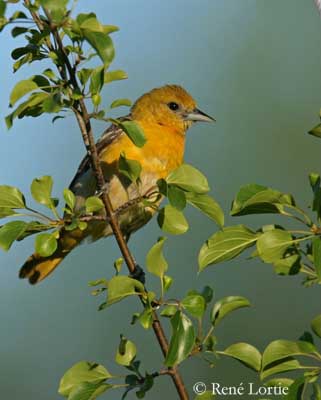
Female has dark brown olive head, and body plumage is paler orange than male. Face, throat and underparts are orange. Tail is olive brown. She has two white wing bars, without orange shoulders. She is smaller than male.
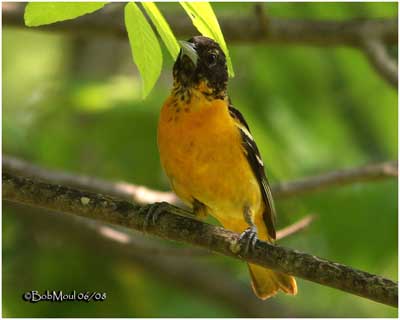
Immature is similar to female, but duller than her. Young male reaches adult plumage in the fall of its second year.
VOICE: SOUNDS BY XENO-CANTO
Baltimore Oriole’s call is a whistled “hew-li”, and a harsh “cheh”, or series of same. Its song is flute-like. Each bird has distinct song. Female utters short and simple songs.
HABITAT:
Baltimore Oriole breeds in open areas with tall deciduous trees, in parks and suburban areas, also along woodland edges.
It winters in wet forests, in flowering canopy trees.
RANGE:
Baltimore Oriole spends summers mainly in eastern United States, from Wisconsin to Maine, southwards to central Mississippi and Alabama, northern Georgia, and western South and North Carolina.
It winters in Florida, Caribbean, Central Mexico, and Central America to northern South America. Some populations are in southern California.
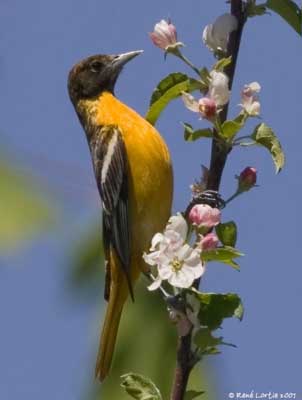
BEHAVIOUR:
Baltimore Oriole searches for food in trees, by gleaning and probing for insects. It runs among branches, clinging by the feet to reach an insect at some distance from it. Sometimes, it glides along the twigs, and at other time, it moves sidewise. It is an elegant bird, but it is not gregarious. It is active during the day.
Baltimore Oriole is an important predator of the pest species, such as caterpillars, eating both larval and pupal forms. It seizes and smashes the large larvae against a branch to break it open and avoid the hair-like structures. It pulls pupae out of their cocoon.
Baltimore Oriole is generally monogamous, but extra-pair copulation may be common. In spring, male performs courtship displays, singing and chattering, hopping from perch to perch in front of female. Male bows to show off its bright colours, with lowered wings and fanned tail.
Female may respond singing and uttering calls, or performing a wing-quiver display, including leaning forwards with tail partly fanned and fluttering lowered wings.
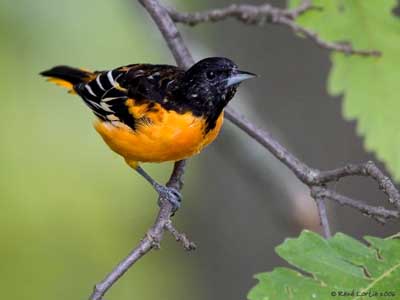
Male and female respond to predators giving alarm calls, chasing and harassing intruders.
Baltimore Oriole may hybridize with Bullock’s Orioles (Icterus galbula bullockii) when their territories overlap. They are now considered as separate species.
FLIGHT:
Baltimore Oriole flies high above trees during migration, and at day. Its flight is straight, strong and continuous.
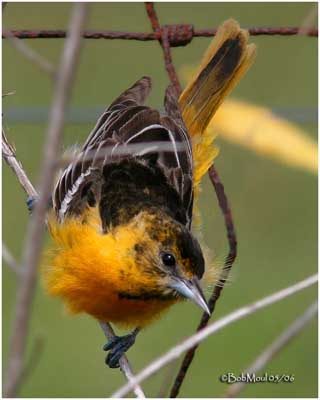
REPRODUCTION:
Baltimore Oriole’s nest is a woven pouch nest, hanging from the tip of a tree branch. Nest is made with fine grasses, fine chips of pliable bark, plant fibres, strings, interwoven neatly and securely. Nest is made in such a manner that the air can easily pass through it. It is hidden among leaves, and built mainly by female. This nest is located at about 25 to 30 feet above the ground, in deciduous trees. It is very beautiful, usually seen only after leaves have fallen.

Female lays 4 to 6 pale grey or pale blue eggs, streaked with dark. Incubation lasts about 12 to 14 days, by female. Chicks hatch altricial. They are fed by both parents, by regurgitation the first few days after hatching. They stay with them for two weeks, always fed by adults during this period.
Young reach their sexual maturity at about one year.
This species produces only one brood per season.
DIET:
Baltimore oriole feeds mainly on caterpillar, larvae and pupae. It also consumes fruits and artificial nectar from bird feeders.
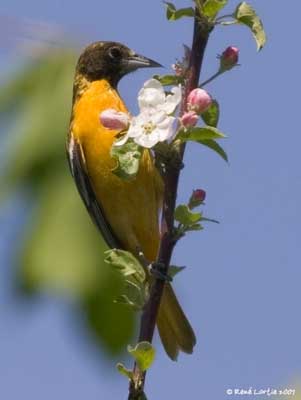
PROTECTION/THREATS/STATUS:
Baltimore Oriole have different predators, such as birds (crows, owls, jays and magpies), and mammals (squirrels, foxes and cats). This species is threatened by habitat loss.
Baltimore Oriole is very important in protecting forests trees, eating some insect pests such as Forest tent caterpillar (Malacosoma disstria).